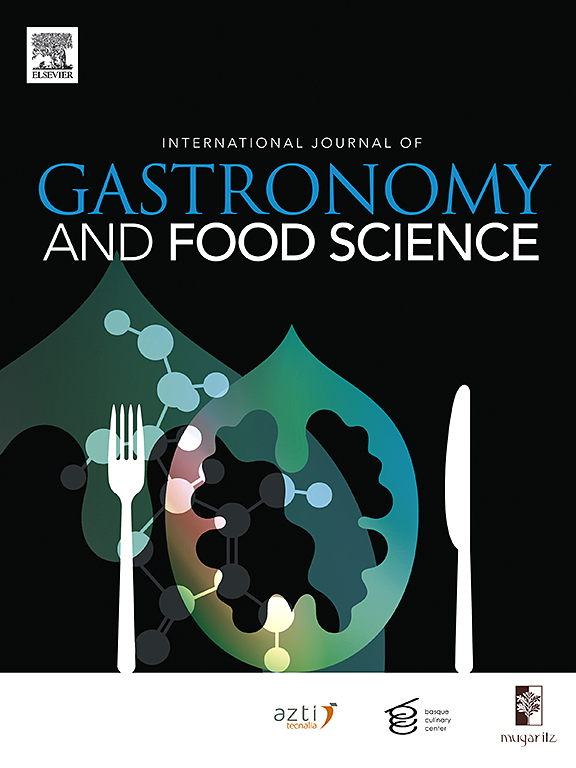Exploring the aromatic and sensory qualities of traditional and genipap meads: insights from Brazilian ingredients and consumer preferences
IF 3.6
2区 农林科学
Q2 FOOD SCIENCE & TECHNOLOGY
International Journal of Gastronomy and Food Science
Pub Date : 2025-06-06
DOI:10.1016/j.ijgfs.2025.101224
引用次数: 0
Abstract
This study aimed to produce traditional and fruit meads using Brazilian raw materials (water, honey, genipap fruit and bee pollen), evaluate their physicochemical characteristics, investigate the profile of volatile compounds present in the drink and check consumer acceptance through affective sensory tests. Traditional (L1 and M1) and genipap (L2 and M2) meads formulations were prepared separately with Lalvin K1-V116 (L) and Mangrove Jack's M05 (M) Saccharomyces cerevisiae yeasts. The fermentations were performed at 24.5 °C for 240 h, followed by 60 days of clarification and packaging of the beverages in glass bottles. The meads showed physicochemical characteristics in accordance with standards established by Brazilian Legislation. A total of 43 volatile compounds were identified, where esters and terpenes were the major classes quantified. The predominant aromas in meads were fruity, floral, sweet and honey-like. Genipap meads exhibited higher antioxidant activity and greater content of volatile esters than traditional meads. The M2 mead showed highest scores in taste and overall acceptability, and higher purchase intention through sensorial analysis by 120 consumers. In this study, the potential of mead production incorporating Brazilian tropical fruits as genipap was demonstrate, with the future possibility of expanding the consumption of this drink in the country.

探索传统和现代面包的芳香和感官品质:来自巴西成分和消费者偏好的见解
本研究旨在使用巴西原料(水、蜂蜜、基尼帕果和蜂花粉)生产传统和水果酒,评估其物理化学特性,调查饮料中挥发性化合物的概况,并通过情感感官测试检查消费者的接受程度。以Lalvin K1-V116 (L)和Mangrove Jack's M05 (M)酿酒酵母分别配制传统(L1和M1)和genipap (L2和M2)酵母制剂。在24.5°C下发酵240 h,然后进行60天的澄清,并将饮料包装在玻璃瓶中。这些牧草的理化特性符合巴西立法规定的标准。共鉴定出43种挥发性化合物,其中酯类和萜烯类是主要的种类。米德酒的主要香气是果味、花香、甜味和蜂蜜味。与传统水稻相比,Genipap水稻表现出更高的抗氧化活性和挥发性酯含量。通过对120名消费者的感官分析,M2蜂蜜酒在口感和总体接受度上得分最高,购买意愿也较高。在这项研究中,将巴西热带水果作为蜂蜜酒生产的潜力得到了证明,未来有可能扩大这种饮料在巴西的消费。
本文章由计算机程序翻译,如有差异,请以英文原文为准。
求助全文
约1分钟内获得全文
求助全文
来源期刊

International Journal of Gastronomy and Food Science
Social Sciences-Cultural Studies
CiteScore
5.30
自引率
10.50%
发文量
170
审稿时长
45 days
期刊介绍:
International Journal of Gastronomy and Food Science is a peer-reviewed journal that explicitly focuses on the interface of food science and gastronomy. Articles focusing only on food science will not be considered. This journal equally encourages both scientists and chefs to publish original scientific papers, review articles and original culinary works. We seek articles with clear evidence of this interaction. From a scientific perspective, this publication aims to become the home for research from the whole community of food science and gastronomy.
IJGFS explores all aspects related to the growing field of the interaction of gastronomy and food science, in areas such as food chemistry, food technology and culinary techniques, food microbiology, genetics, sensory science, neuroscience, psychology, culinary concepts, culinary trends, and gastronomic experience (all the elements that contribute to the appreciation and enjoyment of the meal. Also relevant is research on science-based educational programs in gastronomy, anthropology, gastronomic history and food sociology. All these areas of knowledge are crucial to gastronomy, as they contribute to a better understanding of this broad term and its practical implications for science and society.
 求助内容:
求助内容: 应助结果提醒方式:
应助结果提醒方式:


